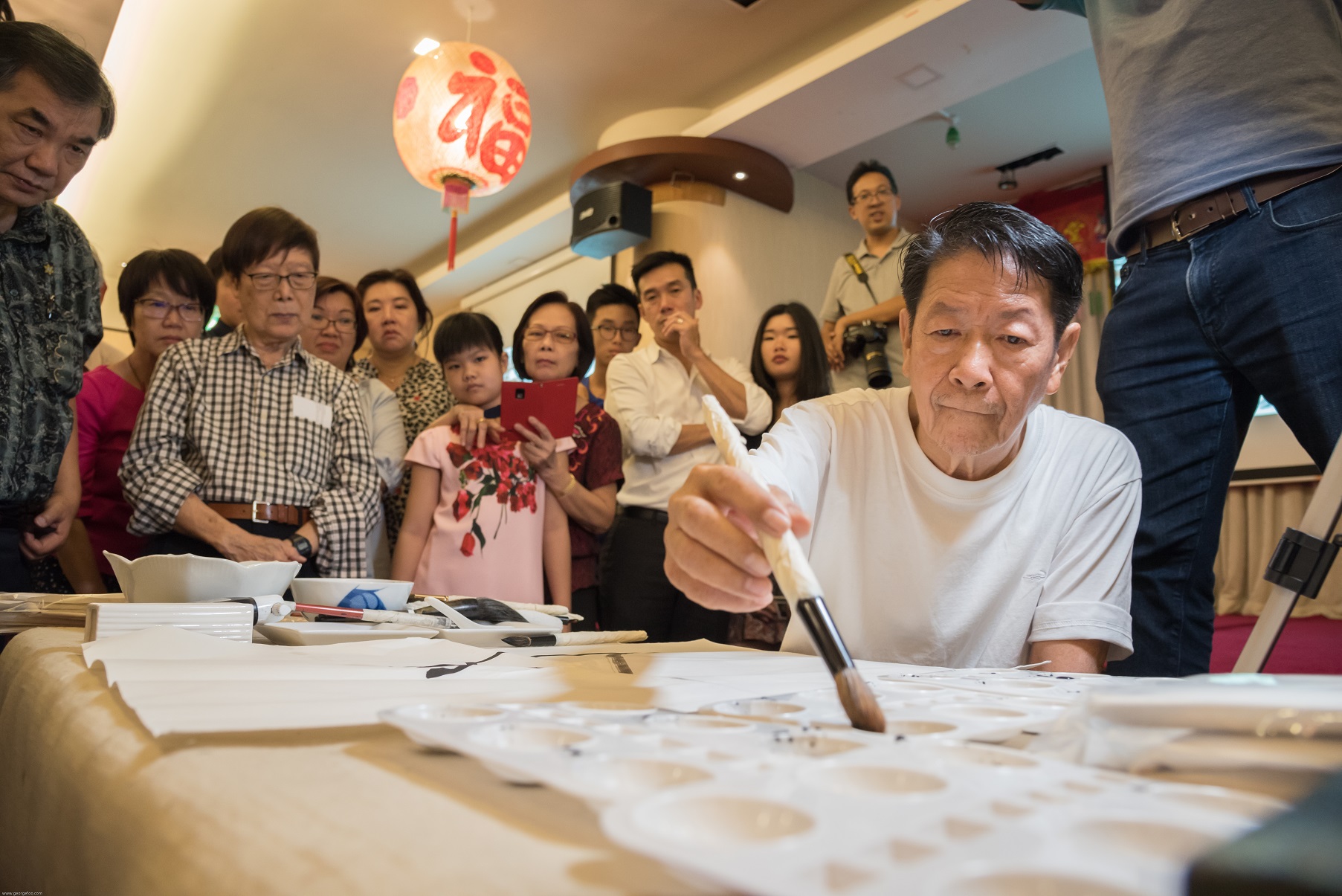Among the audience were several well-known personalities, including President of the Institute of Singapore Chartered Accountants (ISCA) Mr Gerard Ee, former Minister of State for Communications & Information Technology Dr John Chen, Singapore-based international composer and pianist Dr John Sharpley, second-generation artist Mr Khan Siong Ann, as well as local film director Jack Neo.
By Epoch Newsroom
At the Epoch Inspired talk ‘Decipher the Elements of Chinese Ink Paintings of the Highest Order’, art enthusiasts watched intently as grandmaster ink artist Tan Oe Pang painted two crab pictures, which he proceeded to label ‘A’ and ‘B’.“Do you know what’s the difference between A and B?” he asked the 250-strong audience that packed Swatow Seafood Restaurant.
Many looked puzzled and intrigued – the crabs were similar in shape, yet there were subtle differences in their brushstrokes and colour tones.
Using this and several other examples, Mr Tan demonstrated live the various art elements that define the quality of Chinese ink art. Held on February 17, the well-received talk was part of a series of Epoch inspired Talks.
Among the audience were several well-known personalities, including President of the Institute of Singapore Chartered Accountants (ISCA) Mr Gerard Ee, former Minister of State for Communications & Information Technology Dr John Chen, Singapore-based international composer and pianist Dr John Sharpley, second-generation artist Mr Khan Siong Ann, as well as local film director Jack Neo.
Mr Jimi Tan, CEO of Swatow restaurants, was also present at the event. “I am an art collector of Mr Tan Oe Pang[‘s work]. I have collected around 20 pieces of his ink paintings,” he said.


The Difference Between a Drawing and Art

As the audience gathered around for a better view of the live demonstration, Mr Tan unreservedly shared his decades of art expertise.
He explained that Crab A lacked art elements and could only be considered a drawing, whereas Crab B had many art elements incorporated, and would qualify as true art.
According to Mr Tan, art elements refer to the various effects applied to a painting. These include texture, atmosphere, colour, weight, and form. An artist must possess the perception and skill to incorporate these elements in balance, and to express the inner spirit of the painted subjects.

“A painting is drawn [using] traditional foundation[al skills], and without this foundation one cannot be an artist,” stressed Mr Tan, who has been painting since he was five. He trained under Master Fan Chang Qian, the third-generation master of the Hai discipline and a second-generation disciple of the Shanghai School.
“He [Master Fan] taught me the foundation of Chinese ink painting. I started learning from him the basic techniques; there is no shortcut,” he told Epoch Times.
With deft strokes, Mr Tan concluded his demonstration by vividly rendering an impressive colony of frogs in ink. Within a few minutes, the frogs seemed to come alive on paper.
“What I’ve demonstrated proves what I’ve said ‘better than a thousand words’,” said Mr Tan.
Besides incorporating the art elements in balance, Mr Tan also believes in improving one’s moral self to achieve a higher artistic realm.
“You must definitely cultivate your moral character. Only when an artist’s character improves can his painting achieve a higher artistic value,” he said in a post-event interview.
“It is easier to achieve a higher artistic realm if you don’t pursue results,” added the sprightly and energetic 70-year-old.
The Defining Qualities of Chinese Landscape Painting

After Mr Tan’s demonstration, art critic Mr Goh Huck Heng delivered a comprehensive talk on Chinese landscape painting.
“In Chinese landscape painting, a few inches of paper are enough to encapsulate mountain ranges and rivers that run for thousands of miles,” he said.
He added that Chinese landscape painting best showcases the world perspective of Chinese culture. The paintings are never snapshots of the exact scenery, but are manifestations of the artists’ creative process – depicting the spirit of the subject, including its allure, ideas, and inner meanings.
“Without mastering the skills of brush work and ink application, it is impossible to achieve the right union of art elements,” he said.
Mr Goh explained that under the artist’s hand, the brushstrokes can be light or heavy, fast or slow, firm or soft, curvy or straight, sparse or dense, rising or falling, in suspension or in transition. The artist can vary the speed and tempo of the strokes, as well as the different ink tones: dark or light, dry or watery.
All these techniques create unique line drawings that portray different art elements, expressing the artist’s complex aesthetic feelings.
“In Chinese art, objects are observed from numerous perspectives and angles, and rendered on a single piece of paper,” said Mr Goh. “Likewise, events that occurred at different times, or different imaginary scenes, can also be depicted together in one painting. Various perspectives from the bottom, top and front are used to portray scenes and objects. This method is a defining feature of Chinese landscape painting.”
Exploring Tan’s Landscape Paintings, ‘Revival of the Great Tang Period’ and ‘Bengawan Solo’

Analysing Mr Tan’s twin set of landscape paintings, Zai Xian Da Tang (????) or ‘Revival of the Great Tang Period’, Mr Goh said, “It is very difficult and rare to have all three perspectives – pingyuan, gaoyuan and shenyuan – appearing in a single painting.
“But in Da Tang, Master Tan not only combines all three perspectives in one artwork, he also replicates this feat in various parts of the paintings.”
Mr Goh added that the Da Tang paintings “are filled with spirit and energy, yet rooted in the soil of reality. They evoke calm and natural serenity. Amongst the flourishing natural beauty are elements of melancholy and mystery.”
“I once thought [Da Tang] had set an unsurpassable standard, until I saw Master Tan’s latest work – the ‘Bengawan Solo’ (???) series. I realised that I was wrong and that I had underestimated his creative potential,” said Mr Goh.
He noted that the series “transcend[s] the boundaries of ethnicity, culture, geographical territories and religion”. “The series presents a worldview – one that is harmonious, ideal, glorious, and original.”
Boats, bridges, carts and human figures are rendered simple and pure, yet full of vitality and spirit, representing a return to the true essence of life.
“Using the Bengawan Solo river as a medium, Master Tan expresses the idea that all matter, life and experiences begin from a single source, and that in their original state, everything is pure and harmonious,” he said.
He added, “Through the series, Master Tan has expressed an inner state of truthfulness, compassion and tolerance, as well as his spiritual experience in enlightening to the universal truth.”
Studying Tan’s Figure Paintings: ‘Two Sisters’ and ‘Indian Woman’

The event culminated with a talk by Mr Lee Chang Siang, manager of Sky One Art Gallery, in which he analysed two of Mr Tan’s Chinese figure paintings, ‘Two Sisters’ and ‘Indian Woman’.

‘Two Sisters’ was a recent artwork inspired by a fond childhood memory. Drawing inspiration from his simple kampong life in Potong Pasir, Mr Tan painted a little boy returning home from the market place with his mum.
Jack Yu, director of Goshen Art Gallery, particularly liked the painting ‘Indian Woman’. “The painting of the Indian woman has some Tamil calligraphy written on the side. I think this painting is unique and out of the norm,” he said.

In ‘Indian Woman’, Tan depicted a fellow cultivator of Falun Dafa (a spiritual meditation discipline) in Hyderabad, India.
“I often come across Indian women, as I stay near an Indian temple. And the ‘bearing’ which Tan has portrayed was exactly the same as the Indian women I have seen!” said Mr Lee.
Many were captivated and impressed by Mr Goh’s and Mr Lee’s explanations, including Mr Gerard Ee.
He said, “The art pieces are quite profound. It takes a little bit of listening, and remembering what was said in terms of form, and colour to understand an art piece. And slowly, the picture emerges, like the picture of the lady with the child. It is not easy to spot the child initially, but when you hear his explanation, you begin to notice the bird and the child.”

Audience Feedback:
“Mr Tan’s application of the ink on the brush is perfect. The interplay of ink and colour makes each of his line drawings magical. Hence, his painting is fabulous. I believe tonight’s event helped more people understand Chinese ink painting. This is a very precious opportunity for Mr Tan to share his understanding and experiences accumulated over the decades in a very simple and easy-to-understand manner.” – Second-generation artist Mr Khan Siong Ann
“The event tonight taught me how to understand real art. I have learned how to distinguish between an illustration and a Chinese ink painting. It takes just a few brushstrokes for a Master to finish a Chinese ink painting. I found it enlightening to see the different illustrations demonstrated by Mr Tan. The work of a true artist is exceptional.” – Mr Jimi Tan, CEO of Swatow restaurants
“I think the event was very interesting for an artist to do a live demonstration and share with the audience his ways of curating the artwork.” – Mr Jack Yu, Director of Goshen Art Gallery
“I think Mr Tan is a real artist and he actually speaks the truth which is refreshing to hear. He talks about the sense of the art. You don’t only paint the frog but you paint the ‘sense of the frog’. You don’t paint a tree, but you paint the ‘sense of the tree’. I think this is a very powerful message because that ‘sense of something’ is your ‘perception’, and that ‘perception’ is you, and that becomes very spiritual.” – Dr John Sharpley, Singapore-based international composer and pianist
“It is a very interesting talk. The most important lesson I have learned is the difference between a picture and art. I think most people don’t realise this fundamental difference and it is quite profound to hear about the explanation about what does it take to make a piece of work ‘art’ rather than ‘picture’. It is easy to understand through the talk, but quite clearly, it needs years and years of practise. That is why the saying: “It gets better when you get older. There is no shortcut to mastery.” Mr Gerard Ee, President of the Institute of Singapore Chartered Accountants (ISCA) |
















